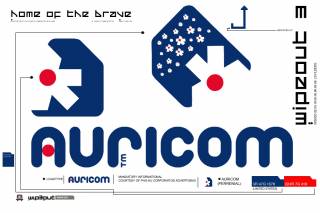Overview
The Designers Republic was established in Sheffield in 1986 by Ian Anderson. The studio widely influenced the field of graphic design, patenting a futuristic style that was well ahead of its time. They were well known for embracing Japanese culture, incorporating Japanese aesthetics into their work such as the Japanese kana and anime style graphics, especially in their early mascot 'Sissy'. They later opened a store in the Shibuya region of Tokyo titled the 'The Peoples Bureau For Consumer Information' that sold items such as clothing, books, stickers and prints.
Some of their most notable clients include: Cartoon Network, Detroit Underground, Electraglide, Hasbro, Lynx, MPC, MTV, Nickelodeon, Nokia, Orange, Pringles, Psygnosis, Reebok, Rockstar Games, Sony, Swatch, VH-1 and Warp Records.
Past Members:
History
Ian Anderson, the studio's founder, first started designing when he was still in high school, creating artwork for local artists. The studio was officially founded in 1986. One of Anderson's earliest designs was an album cover that was hand-drawn but emulated computer-esque imagery, well before computers were even capable of creating such images. In an interview in 2001, Anderson revealed that the provocative graphic style was actually a result of him unaware with proper standards in typography and design.
People used to say ‘you’re at Designer’s Republic because you break the rules’ and we’d say ‘we’re not really, we just don’t know the rules… Every time someone rang up about work we’d put the phone down, piss ourselves laughing and say ‘one day someone’s going to suss out that we don’t know what we’re doing’. We used to take on students for work placement so that we could learn from them. I got my first lesson in typography from someone at a typesetters who was sick of trying to work out my instructions.
 Design for Wipeout 3.
Design for Wipeout 3.They continued to design album covers, gathering more and more attention and in 1994 appeared in influential design magazine Emigre, with the issue currently fetching large sums on eBay. Arguably their most well-known work is with the music label Warp Records, designing many of their album covers and website. In 1995 they were brought on to design the artwork for WipEout. They would go on to work on the following two games, WipEout XL and WipEout 3. WipEout 3 is infamous for its minimalist graphic design, with the title screen simply featuring the words 'Wipeout Three Title Screen'. The studio also worked with Rockstar Games to design the box art for the original Grand Theft Auto.
In January 2009, the studio went into voluntary liquidation, with all nine positions being made redundant. Ian Anderson stated that the cause was a loss of a few important clients, late payments for completed projects and a large amount of due tax. He also revealed that he made several bad decisions by hiring people lacking the creativity that the studio stood for.
I believe passionately about what TDR does. When I took a back seat to allow it to grow beyond me, it died; its creative spark was crushed under the weight of business self-interest. I’m not saying I was blameless, it’s just that the more I tried to take myself out of the equation to see if TDR could grow better without me, the more obvious it became that Ian Anderson and The Designers Republic were inseparable.
While Anderson lost a large amount of money as a result of the closure, he also stated that the closure was a "blessing in disguise", revealing that he felt the studio had lost sight of what it originally stood for by working with such major clients such as Coca-Cola and having to deal with business types, but conceded that it was a valuable learning experience. In an interview, he revealed plans to start the studio again, focusing on a more direct client interaction more in line with the studio's beginnings. Since the closure, Ian Anderson has used the Designers Republic name on designs for electronic duo Autechre's 'Oversteps' album and 'Move Of Ten' EP.
Log in to comment